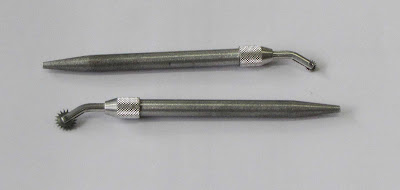Factors relating to how to determine an annealing soak time and cool rate are numerous. The thicker the piece, the more conservative you need to be in the soaking and cooling. This is because the annealing soak time increases almost exponentially with the thickness of the piece. The reduction in the speed of the anneal cooling has an approximate exponential relationship also – requiring much slower rates of cooling.
In the simple case you use the smallest dimension to determine the thickness for annealing. The heat is assumed to travel the shortest distance to dissipate. Thus a piece cooled from both sides will be taken as the simple case. This needs to be modified in a number of circumstances.
1 - Pieces cooled from one side, as where the shelf is heat retentive, or fired on the base of the kiln can effectively cool from only one side. This doubles the distance the heat has to travel. So you need to use the numbers from any annealing table for glass twice the thickness of the actual piece.
2 - Then if you have variations in the thickness of the piece, you need to be more careful, because the thinner areas will cool faster than the thicker, giving the potential for stress creation.
3 - If you are doing anything less than a full fuse, you will need to be more careful. If the pieces are tack fused, they will in part, act independently of each other and so need more careful, slower annealing.
4 - The less symmetrical a piece is, the greater care needs to be taken, just as with differences in thickness.
5 - The heavier or more insulating the refractory materials that surround the piece, the greater the care needed in annealing.
A rule of thumb is to consider these variables and add to the soak times and reduce the speeds of anneal cooling in accordance with the number of variables exhibited in your piece. With the first of these variables - cooling from one side - use the schedule for twice the actual thickness of the piece. Then add another step up in thickness for each additional variable.
So, as an example, the most common complicating factor is the inability of the kiln to cool the pieces equally from both sides. This requires you to double the thickness to read an appropriate schedule from the table making the schedule for 12mm glass.
But your piece of glass also varies in thickness, so you need to add another step up in thickness, giving you 19mm.
However you are not intending to go to a full fuse, so you need to add another thickness. Now you are up to the table for 25mm.
But the pieces are asymmetrical, so another step up in thickness is required giving you 38mm.
And you have heavy dams under and around the piece, so yet another thickness level is required to read an annealing schedule from the table. This gets you up to 50mm as the part of the table you should be reading from. So you will need an 8 hour soak rather than 1 hour and need to reduce the temperature at 4C/hour rather than 80C/hour.
Of course, not every project has all these variables in it, so you use only those that apply, but each of those that do apply requires a step up in thickness to read the schedules for the numbers to plug into your controller.
This is a rule of thumb, so you will need to test any pieces for stress and learn from your experience if this is conservative enough for you pieces.







